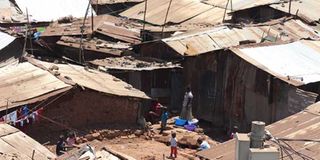How to make housing affordable to those with very low incomes

Mathare Slums. Data shows that more than 70 per cent of Nairobi residents live in slums. This is surprising, considering that housing is the bedrock of any strong economy. PHOTO | DENNIS ONSONGO
What you need to know:
- Data shows that more than 70 per cent of Nairobi residents live in slums. This is surprising, considering that housing is the bedrock of any strong economy.
- Having citizens access good housing has a multiplier effect with the potential to create employment, promote livelihoods and contribute to the country’s economic transformation.
- The government can draw up forward-looking policies that create solutions favouring the poor, an example being zoning, that is, the way the government controls the physical development of land and the kinds of uses to which particular areas may be put.
At the centre of the Sustainable Development Goals (SDGs), is Goal Number 11: Make cities inclusive, safe, resilient, and sustainable.
According to UN Habitat, the key target of Goal 11 is to ensure that all people access adequate, safe and affordable housing. However, data shows that more than 70 per cent of Nairobi residents live in slums. This is surprising, considering that housing is the bedrock of any strong economy. Having citizens access good housing has a multiplier effect with the potential to create employment, promote livelihoods and contribute to the country’s economic transformation.
Creating a housing market that accommodates low-income earners should be a priority for Kenya’s policy makers. The prospect for success on this front, however, remains elusive. Given that land is the main input in the housing value chain, recent price increases put housing prices beyond the reach of low-income earners.
Finding solutions that make housing affordable and accessible should be the main objective. Industry players have tested mechanisms that can create affordable housing. But even though using new technology is commendable, it does not necessarily make houses cheaper. For example, one might use cheap construction materials but the design model requires more input and, therefore, increases the price of the house. Looking at the problem from a sector perspective rather than from a specific chain is necessary and allows more room for innovation and solutions.
TAX CREDITS
The government has played a distinctive role in solving the housing problem for the poor. Examples include the Kibera slums housing project and, more recently, Nairobi Governor Evans Kidero announced plans to build more than 10,000 houses. These are well-intentioned projects, but evidence suggests they are likely to get mired in red tape and will not benefit those they are intended for.
So, what can Kenyan policy makers do to make housing affordable for the poor?
One is policy intervention. The government can draw up forward-looking policies that create solutions favouring the poor, an example being zoning, that is, the way the government controls the physical development of land and the kinds of uses to which particular areas may be put. This controls the demand and price of land in a given area. Taking away the demand makes the land less given to speculation and makes houses built in a given area limited to a certain price. County governments should also be given the authority to decide that only houses costing a certain amount can be built in each zone.
Over time, zoning has worked in Canada, Australia and the UK
Another intervention is subsidising. Subsidising decreases the price of houses along the value chain. Research has shown that the cost of subsidising housing is higher than the that of not subsidising it since housing is a basic need that also contributes to human development and increases the GDP.
Besides, the government can create incentives for affordable housing through tax regimes. This encourages investors as well as developers to carry out more large-scale affordable housing projects. For example,
The Low-Income Housing Tax Credit (LIHTC), a programme designed in the ’80s, is the most important resource used in developing affordable housing in the United States today. Data shows that the programme led to the created 43,092 projects and 2.78 million housing units between 1987 and 2014. This project accounts for over 90 per cent of all affordable housing in the United States.
Kenya, and Africa as a whole, should follow these steps and create an affordable housing market. We only need political will to take the first step.
Oumar Diop is the director of project management at Shelter Afrique




